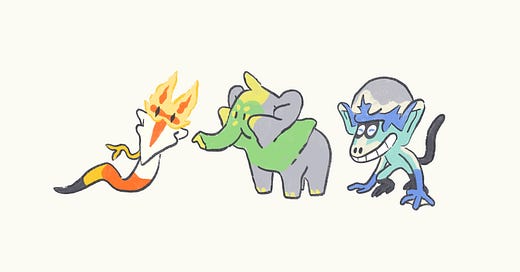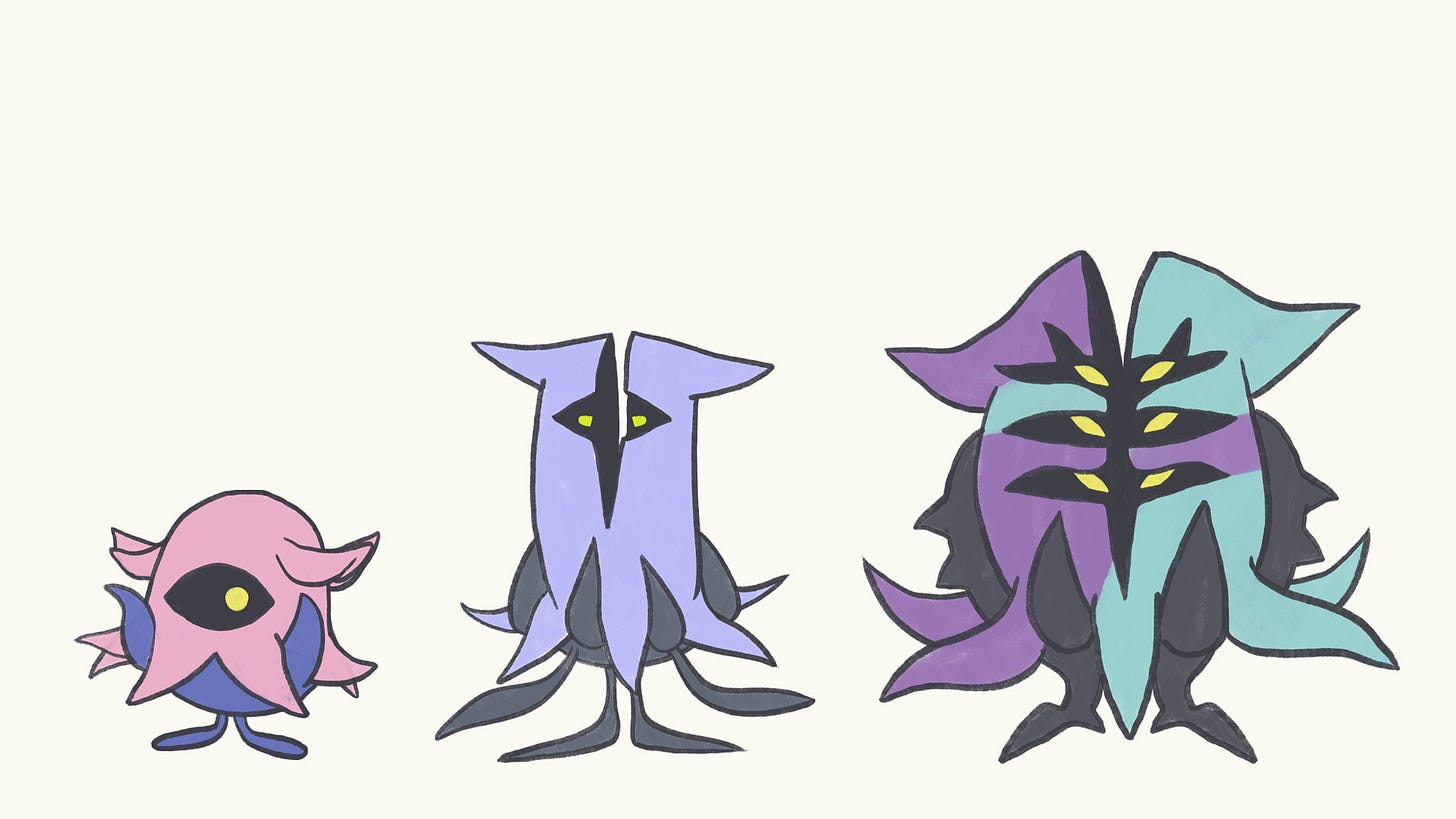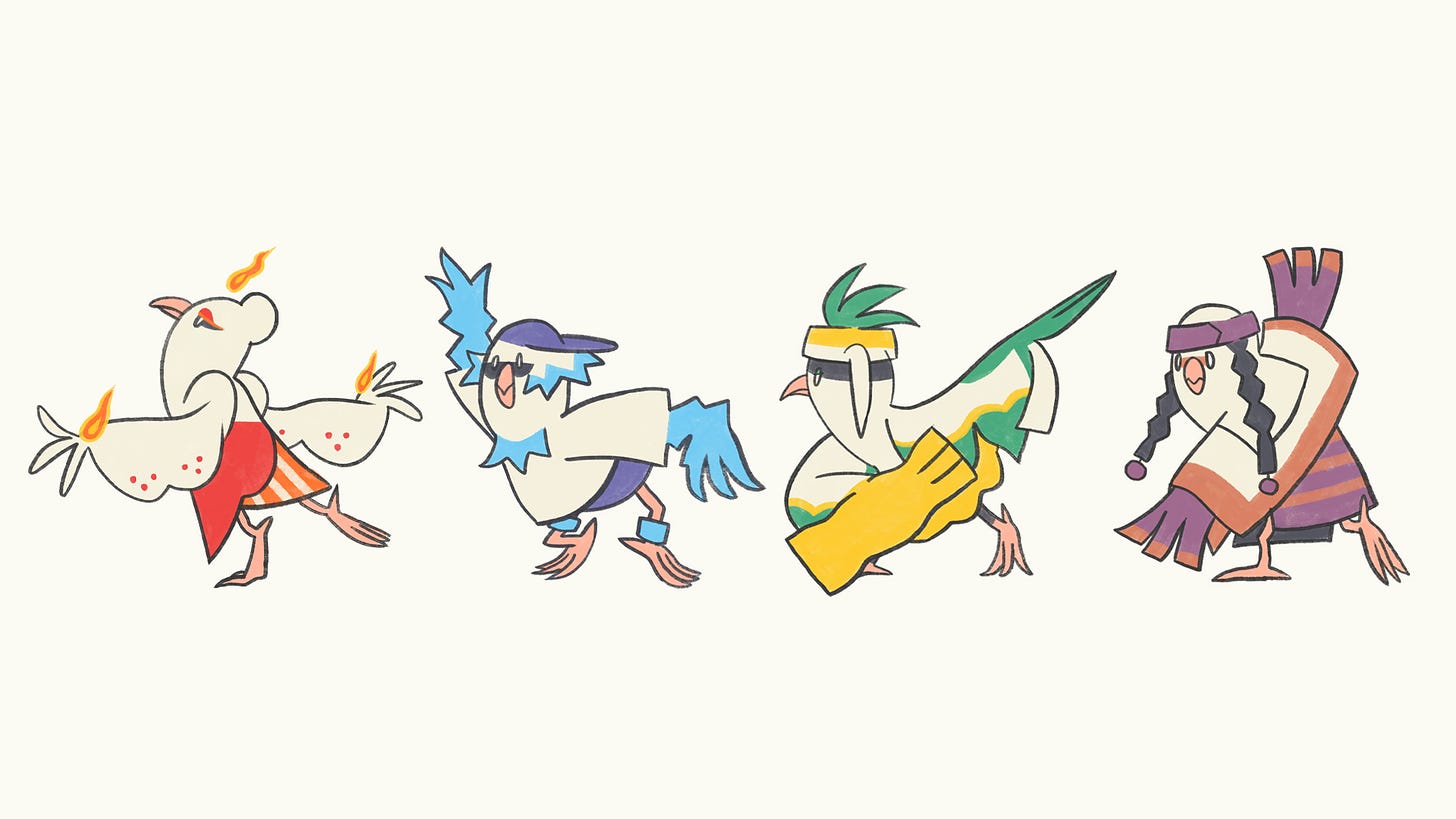A Fan-made Pokédex Rich in Filipino Imagery
Can you catch all of Tonbi Region's Filipino-themed references?
This story is part of the launch issue of Offworlds, my monthly newsletter about the video games made and played by Filipinos. Please consider subscribing!
One of my new favorite Pokémon is a Psychic-Fairy hybrid called Mariacleara. It takes the shape of a humanoid specter looking very serene in what appears to be a Filipiniana gown. According to its lore, its aura “prevents anyone from creating dishonest or malicious thoughts,” which makes it an indispensable presence during court hearings in its home region of Tonbi.
The catch is that you won’t find Mariacleara recorded in Game Freak’s official Pokédex—it’s actually one of 128 fan-made Pokémon on Instagram created by a Quezon City-based designer and illustrator who goes by @tonbiregion. Fan projects built around the invention of these ‘Fakemon’ have been around for a long time, from fusions of first-gen Pokémon to crossovers with The Legend of Zelda. What especially drew me to @tonbiregion’s work was his devotion to mostly Filipino themes and references.
“Initially, it was just supposed to be found around the center of the world, and I decided to go full Philippine-themed somewhere in the middle,” he wrote to me. Although we haven’t been shown what the region may actually look like, he says Tonbi’s geography influences the trajectory of his Pokémon’s designs. “I think about where [a Pokémon is] gonna live, or what it would be interacting with. Pokémon’s fun because you’re not just bound to creating an ‘animal’.”
This approach has resulted in monsters like Cowvalry, which is inspired by the symbiotic relationship between carabaos and the assortment of birds usually perched on their backs. There’s also Pandesan and its evolutions Terapay and Panatera, who are not only hilarious references to the bags of pandesal that Filipinos enjoy for breakfast but are also a nod to National Artist Arturo Luz’s Anito sculptures.
Followers of the page come from different parts of the world, @tonbiregion mentions. “It feels nice to see them appreciate these bits of culture that foreigners don't usually see, like local art, fashion, our own language, and even food!”
Some of his more interesting references are deep cuts into Filipino pre-colonial history, like Suyat, the Ancient Text Pokémon that comes in four forms. Each form follows a specific indigenous script like Baybayin, as well as lesser known writing systems like Kulitan, which originated in the region that is now Pampanga. A more contemporary reference comes in the shape of Oricorio's ‘Budots Style’ form, who appears in “birthdays and street parties to spread their contagious electricity and dancing.”
Tonbi Region’s visual style is also worth mentioning, which evokes memories of the mellow watercolor style used by Ken Sugimori when he designed the first 150 Pokémon. “I was inspired by Ōkami a lot but midway I just vibed with this rough painterly aesthetic,” @tonbiregion writes in one of his Instagram posts.
He also paid great attention to the unique properties and backstories of each Pokémon to make sure every monster doesn’t feel redundant. He uses Ghost types as an example: “Each one will be spooky or have some access to the afterlife. So what can x-Ghost Pokémon do that y-Ghost Pokémon can’t? They become more interesting and novel that way, once they have a role to play in the world that only they could pull off.”
In practice, you have Pokémon like Severaith, a Ghost type inspired by the Manananggal, who has the ability to split into two fully functioning Pokémon during a double battle. There’s also one called Skeetah who evolves after maxing its Speed stat into the Ghost-Electric hybrid Spektah, becoming “so fast it lost its physical form, turning it into a ghost.”
Despite the great variety of his source materials and inspirations, @tonbiregion found a very clever way to tie the project together with the name Tonbi, a play on bituin, the Tagalog word for ‘star’.
“Since I’m basing it on the Philippines, I wanted a name that can somehow represent the country well. While looking for words to base the name on, I saw that our word for ‘star’ is similar across different languages,” he wrote.
During his research, @tonbiregion found same-sounding words for bituin from other languages: vituhen in Ivatan, bitoon in Waray, and bituun in Tausug. And although he warned that his references are limited to what Google spits out, he still considers it a very interesting personal discovery.
“It makes you wonder how much astronomical significance they played in the lives of all these groups across the Philippines. It was that important for all of them that they got along and agreed that, ‘hey guys, this is going to be what we call those dots in the sky’.”
At the time of this writing, @tonbiregion has released 120 out of his planned 128 Pokémon. He cites other Fakemon artists who have greatly expanded upon their work like Marco Smith, whose Pokédex numbers in the thousands, and another Filipino-themed region called Bayan that’s currently being developed into a playable fan game.
Tintado, the 116th entry in Tonbi’s Pokédex, reads like a manifestation of @tonbiregion’s artistic journey when he set out to begin this project as a personal test of consistency. A Pokémon frustrated by its own perfectionism, Tintado can “spend days sulking on tree branches, etching a beautiful drawing, only to paint over everything right after.” However, it eventually evolves into its final form called Bintura after “overcoming its artistic frustrations.” With eight Pokémon left to draw, @tonbiregion seems to have prevailed over his own challenges in this project.
“I was talking to a friend I met through this project and he’s right in saying it’s kind of bittersweet because I’m done,” he wrote. “But also, I’m done! Let’s wait and see where I’ll go from #128.”
You can follow @tonbiregion on Instagram. As a deal he made with himself, he says he chose not to attach his real name to the project until he was done.







